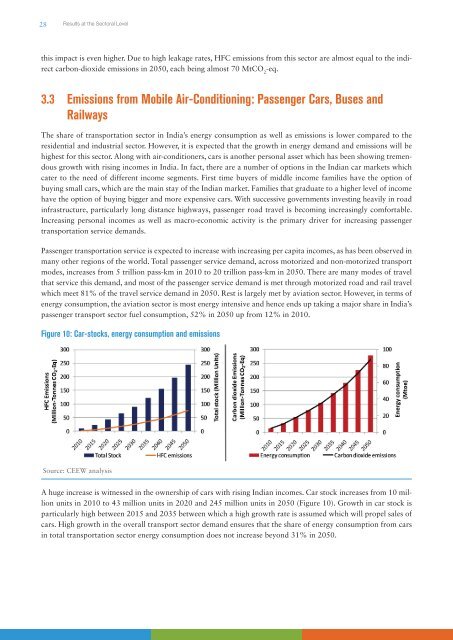Hydrofluorocarbon Emissions-Shakti Sustainable Energy Foundation
One such critically important category of gases is hydrofl uorocarbon (HFC). HFCs are potent greenhouse gases and are expected to contribute signifi cantly to global warming by 2050 (IPCC/TEAP, 2006; Velders et al., 2009; Gschrey et al., 2011; Miller & Kuijpers, 2011; Höglund-Isaksson et al., 2013). Read more information visit: http://shaktifoundation.in/report/indias-long-term-hydrofluorocarbon-hfc-emissions-detailed-cross-sectoral-analysis/
One such critically important category of gases is hydrofl uorocarbon (HFC). HFCs are potent greenhouse gases and are expected to contribute signifi cantly to global warming by 2050 (IPCC/TEAP, 2006; Velders et al., 2009; Gschrey et al., 2011; Miller & Kuijpers, 2011; Höglund-Isaksson et al., 2013). Read more information visit: http://shaktifoundation.in/report/indias-long-term-hydrofluorocarbon-hfc-emissions-detailed-cross-sectoral-analysis/
You also want an ePaper? Increase the reach of your titles
YUMPU automatically turns print PDFs into web optimized ePapers that Google loves.
28<br />
Results at the Sectoral Level<br />
this impact is even higher. Due to high leakage rates, HFC emissions from this sector are almost equal to the indirect<br />
carbon-dioxide emissions in 2050, each being almost 70 MtCO 2<br />
-eq.<br />
3.3 <strong>Emissions</strong> from Mobile Air-Conditioning: Passenger Cars, Buses and<br />
Railways<br />
The share of transportation sector in India’s energy consumption as well as emissions is lower compared to the<br />
residential and industrial sector. However, it is expected that the growth in energy demand and emissions will be<br />
highest for this sector. Along with air-conditioners, cars is another personal asset which has been showing tremendous<br />
growth with rising incomes in India. In fact, there are a number of options in the Indian car markets which<br />
cater to the need of different income segments. First time buyers of middle income families have the option of<br />
buying small cars, which are the main stay of the Indian market. Families that graduate to a higher level of income<br />
have the option of buying bigger and more expensive cars. With successive governments investing heavily in road<br />
infrastructure, particularly long distance highways, passenger road travel is becoming increasingly comfortable.<br />
Increasing personal incomes as well as macro-economic activity is the primary driver for increasing passenger<br />
transportation service demands.<br />
Passenger transportation service is expected to increase with increasing per capita incomes, as has been observed in<br />
many other regions of the world. Total passenger service demand, across motorized and non-motorized transport<br />
modes, increases from 5 trillion pass-km in 2010 to 20 trillion pass-km in 2050. There are many modes of travel<br />
that service this demand, and most of the passenger service demand is met through motorized road and rail travel<br />
which meet 81% of the travel service demand in 2050. Rest is largely met by aviation sector. However, in terms of<br />
energy consumption, the aviation sector is most energy intensive and hence ends up taking a major share in India’s<br />
passenger transport sector fuel consumption, 52% in 2050 up from 12% in 2010.<br />
Figure 10: Car-stocks, energy consumption and emissions<br />
Source: CEEW analysis<br />
A huge increase is witnessed in the ownership of cars with rising Indian incomes. Car stock increases from 10 million<br />
units in 2010 to 43 million units in 2020 and 245 million units in 2050 (Figure 10). Growth in car stock is<br />
particularly high between 2015 and 2035 between which a high growth rate is assumed which will propel sales of<br />
cars. High growth in the overall transport sector demand ensures that the share of energy consumption from cars<br />
in total transportation sector energy consumption does not increase beyond 31% in 2050.

















